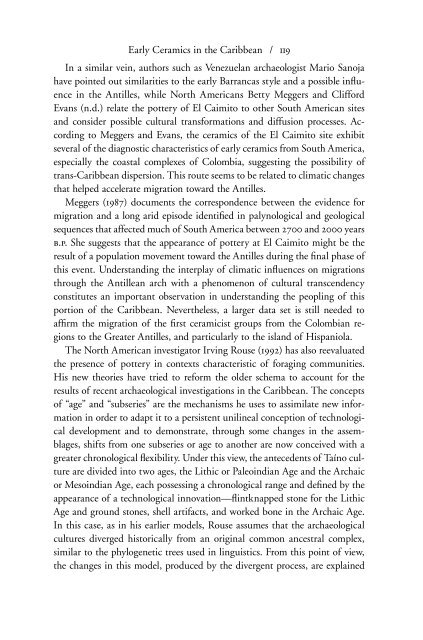Dialogues in Cuban Archaeology
by L. Antonio Curet, Shannon Lee Dawdy, and Gabino La Rosa Corzo
by L. Antonio Curet, Shannon Lee Dawdy, and Gabino La Rosa Corzo
You also want an ePaper? Increase the reach of your titles
YUMPU automatically turns print PDFs into web optimized ePapers that Google loves.
Early Ceramics <strong>in</strong> the Caribbean / 119<br />
In a similar ve<strong>in</strong>, authors such as Venezuelan archaeologist Mario Sanoja<br />
have po<strong>in</strong>ted out similarities to the early Barrancas style and a possible <strong>in</strong>®uence<br />
<strong>in</strong> the Antilles, while North Americans Betty Meggers and Clifford<br />
Evans (n.d.) relate the pottery of El Caimito to other South American sites<br />
and consider possible cultural transformations and diffusion processes. Accord<strong>in</strong>g<br />
to Meggers and Evans, the ceramics of the El Caimito site exhibit<br />
several of the diagnostic characteristics of early ceramics from South America,<br />
especially the coastal complexes of Colombia, suggest<strong>in</strong>g the possibility of<br />
trans-Caribbean dispersion. This route seems to be related to climatic changes<br />
that helped accelerate migration toward the Antilles.<br />
Meggers (1987) documents the correspondence between the evidence for<br />
migration and a long arid episode identi¤ed <strong>in</strong> palynological and geological<br />
sequences that affected much of South America between 2700 and 2000 years<br />
b.p. She suggests that the appearance of pottery at El Caimito might be the<br />
result of a population movement toward the Antilles dur<strong>in</strong>g the ¤nal phase of<br />
this event. Understand<strong>in</strong>g the <strong>in</strong>terplay of climatic <strong>in</strong>®uences on migrations<br />
through the Antillean arch with a phenomenon of cultural transcendency<br />
constitutes an important observation <strong>in</strong> understand<strong>in</strong>g the peopl<strong>in</strong>g of this<br />
portion of the Caribbean. Nevertheless, a larger data set is still needed to<br />
af¤rm the migration of the ¤rst ceramicist groups from the Colombian regions<br />
to the Greater Antilles, and particularly to the island of Hispaniola.<br />
The North American <strong>in</strong>vestigator Irv<strong>in</strong>g Rouse (1992) has also reevaluated<br />
the presence of pottery <strong>in</strong> contexts characteristic of forag<strong>in</strong>g communities.<br />
His new theories have tried to reform the older schema to account for the<br />
results of recent archaeological <strong>in</strong>vestigations <strong>in</strong> the Caribbean. The concepts<br />
of “age” and “subseries” are the mechanisms he uses to assimilate new <strong>in</strong>formation<br />
<strong>in</strong> order to adapt it to a persistent unil<strong>in</strong>eal conception of technological<br />
development and to demonstrate, through some changes <strong>in</strong> the assemblages,<br />
shifts from one subseries or age to another are now conceived with a<br />
greater chronological ®exibility. Under this view, the antecedents of Taíno culture<br />
are divided <strong>in</strong>to two ages, the Lithic or Paleo<strong>in</strong>dian Age and the Archaic<br />
or Meso<strong>in</strong>dian Age, each possess<strong>in</strong>g a chronological range and de¤ned by the<br />
appearance of a technological <strong>in</strong>novation—®<strong>in</strong>tknapped stone for the Lithic<br />
Age and ground stones, shell artifacts, and worked bone <strong>in</strong> the Archaic Age.<br />
In this case, as <strong>in</strong> his earlier models, Rouse assumes that the archaeological<br />
cultures diverged historically from an orig<strong>in</strong>al common ancestral complex,<br />
similar to the phylogenetic trees used <strong>in</strong> l<strong>in</strong>guistics. From this po<strong>in</strong>t of view,<br />
the changes <strong>in</strong> this model, produced by the divergent process, are expla<strong>in</strong>ed


















